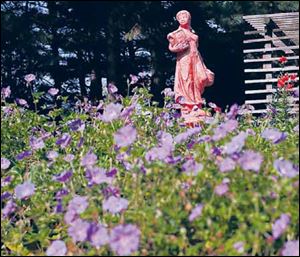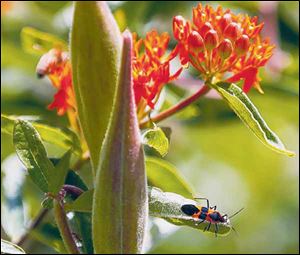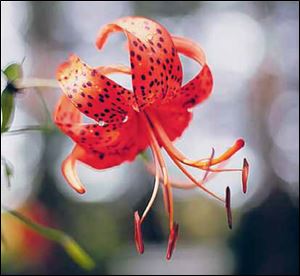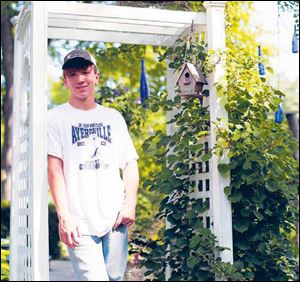
WEED IT & REAP
Johanna and Bill Mack, retired teacher and retired principal, living just outside of Defiance.
8/13/2014
Johanna and Bill Mack, retired teacher and retired principal, living just outside of Defiance.
THE BLADE/AMY E. VOIGT
Buy This Image

Johanna and Bill Mack, retired teacher and retired principal, living just outside of Defiance.

'Rozanne perennial geranium' surround a statue.
DEFIANCE — The stumpery in the Macks’ ravine is not the most glorious of their 19 garden beds; it is, however, a quaint oddity that even Prince Charles has embraced. Tree roots, their stubby legs pitching every which way, rest on sides or upside down, surrounded by tapering ferns, hostas, myrtle, brunnera, and the dainty rosettes of hens and chicks in the bowl of an antique bird bath.
Quick aside: When his father, Prince Philip, first saw the stumpery at his son’s home, he’s said to have remarked, “When are you going to set fire to this lot?”
The Macks’ modest version contains eight stumps from about 150 ash trees that, felled by ax or wind, crashed to earth, yanking out their weak roots. Another 100 ghostly ashes remain standing.
PHOTO GALLERY: Weed It & Reap with Johanna and Bill Mack
Johanna (a Whitmer High School graduate) and Bill Mack (Paulding High School) met when they taught at the same elementary school in Columbus. In 1889, Bill’s great-grandparents bought Defiance County acreage that was also worked by his grandparents. Bill’s parents rented it to farmers. They lured the young couple back to Northwest Ohio with the promise of an acre on which to build a home, and they did so in 1967 on what had been cornfield. To separate their home from cornstalks and to break the wind, they planted 170 evergreen seedlings, now mature.
Johanna taught English at junior high; Bill taught fifth and sixth grades and was principal at three Defiance schools.
Their property grew to 14 acres, about 12 of ravine, its steep wooded sides flanking bottom land cut by a creek that feeds the nearby Tiffin River. When their two children were young, the ravine hosted cows, horses, goats, geese, rabbits, and chickens kept for food and 4-H projects.
The lowland’s biggest flood was during a mild February in 2008: U.S. 24 was being widened to four lanes and construction equipment had partially dammed the Tiffin River.
Over the creek they’ve built five little bridges; one has the iron spans of a bridge cast in 1885 that was originally over a ditch on Buckskin Road. Another bridge is guarded by huge plywood cutouts of the Mad Hatter, Cheshire Cat, and the White Rabbit, along with two oversized teacups brimful of moss roses. They made the cutouts for a 2010 garden tour, the year the movie Alice in Wonderland was released.

Butterfly weed.
Johanna had long mulled installing large pond and in 1987 they proceeded after careful consideration of the lay of the land, its springs, and the creek.

Tiger lily.
“We want to do what the land wants,” Johanna said.
In 2005, Kevin Smith of Defiance built a 14-foot waterfall into the ravine; it curves around stone paths lined with flowers and spills into the pond. Bill stocks the pond with bass, bluegill, and coy, and this year, added five tilapia in one of the waterfall’s pools, but believes the water snakes made sushi out of them.
When the children grew up, the Macks dispensed of the livestock and Johanna landscaped more avidly, around the barn, the chicken coop, in the ravine. The couple retired 20 years ago, and after she hit 70, she decided 25 beds were simply too many.
“You have to be realistic and understand you don’t have the energy you had when you were 40, 50, 60 years old,” she said. “It’s hard to cut back. I loved what was in those beds. I started with the beds farthest from the house. ”
She’s given away untold bags of perennials, including four large clumps of tiger lilies last week.
Four years ago, a 10-year-old boy pedaled his bike down their drive looking for work. He was bored, he said, and would work for two dollars an hour. Juan Castillo, 14, is quiet, curious, and hardworking. He’s been their reliable extra set of hands and honorary grandson ever since, learning about perennials, trees, fish, and the deer and her triplets who visit at night.
A few years ago Juan found an emaciated, mewling kitten in the ravine. Memphis, white with a tabby-colored tail, is part of the household but still a tad feral.
Another bed is in the process of being halved with Juan’s help.
“I’m probably through reducing until I turn 80,” said Joyce.
Like most gardens, it continues to be tweaked. A few years ago, Bill moved several messy bird feeders hanging from a black walnut branch, and on the chains that remained, he attached 11 blue wine bottles. They’re especially winsome when pierced by the sun.
“We emptied all the bottles ourselves,” he said.
Garden specs: Nineteen beds, 18 flower and one vegetable, on a few of our 14 acres.
When did you start gardening? In 1967 when we moved here. Both of our grandparents were farmers, so the love of the land seems to be in our blood.. Johanna’s grandmother was an organic gardener, living off Hill Avenue and in Holland. And her paternal grandfather was adamant about not using DDT on his fields.
What do you grow? We are so fortunate to have a large space which allows for drifts of color and a variety of trees, shrubs, and plants. We’ve got bear’s breeches, bottlebrush buckeye, Arkansas amsonia, goat’s beard, European wild ginger, blue false indigo, bergenia, clematis, Russian sage, hibiscus, water iris, horsetail, bee balm, anemone, poppy.
Dozens of hosta varieties, coral bells, 3,000 daffodils that bloom over a five-week period (we don’t have tulips because deer eat them), perennial geranium (blooms all summer and deer don’t eat it). Sedums, grassses, ferns, vines.
Trees include kousa dogwood, purple robe locust tree (it’s covered in fragrant purple blooms in spring), three magnolias (loebner, tulip, and star), japanese maple, crimson king maple, redbuds. Bill has transplanted and is nurturing a dozen redbud saplings that, when grown, will be visible from the road).
Favorite plants: Johanna: In spring it’s forsythia, redbud trees, Virginia bluebells, and daffodils. In summer, it’s Rozanne hardy geranium (a violet-blue perennial that blooms for months and the deer don’t eat it), and hostas. Fall favorites are the colorful leaves of maples and astilbe. In winter, the cinnamon colored paper-bark maple near the house is stunning against the snow.
Bill: ornamental grasses.
Juan: Phlox, blooming now in bright pink and fuschia..

Juan Castillo, 14, gardens with the Macks.
Give us a tip: Mulch, mulch, mulch. I use black chipped wood, it really makes the colors of the flowers pop. Mulch reduces the need to water and weed, and as it breaks down, it improves the soil.

Anemones in bloom against the pond.
Another tip: Use bone meal for healthy daffodils. When I’m planting a blub, I put it in the hole and mix it with dirt, and for daffs already planted, shortly after they’re done blooming, I scatter bone meal around them.
And to fill pots inexpensively, use perennials such as hostas, sedum, heuchera (coral bells), black-eyed susans, and grasses. I leave them outside in the pots all winter.
To save begonias over the winter: before the first frost remove foliage, wash all dirt off the bulb and let it dry, put it in a paper bag in a cool, dry place. In February, plant it in the pot it will remain in and put in a warmer, sunny place until they’re ready to be hardened off.
Hours spent per week: 40 between Bill and Joanna; more in the spring. In addition, we’ve spent a lot of time dealing with dead ash trees..
Annual expense: About $2,200 for two dump-truck loads of mulch, a load of top soil, professional treatment for invasive plants, vegetables, and a few perennials.
Challenges: Accepting the need to reduce beds and purging overgrown plantings. Also, trying to outsmart the deer: what’s worked well is four-foot netting attached to stakes around part of hosta bed that’s in the path of the deer. And, it’s been difficult watching our ash trees die and then dealing with their wood and brush. I have a couple spots I leave brush for the animals.
I’m proud of: Our waterfall. Water from our pond is pumped up the ravine 14 feet and cascades down and along a curvy route with five additional falls before returning to the pond. Most of Defiance is very flat.
What do you get out of gardening: It’s great therapy. While I was teaching, I appreciated that the plants did not talk back, thrived where I put them (most the time), and showed their appreciation by blooming spectacularly. And after a day of weeding, it’s satisfying to see what a person can create with the help of Mother Nature.
It is also fun to watch the antics of deer, raccoon, herons, foxes, coyote, and all kinds of birds. An eight-point buck once bedded down between the house and the corn during hunting season, a raccoon turned on our outdoor water faucet one night; we’ve watched fawns chase turkeys, and have had an opossum look into the patio door.
Garden Calendar
■ Interested in becoming a Master Gardener? Informational meetings explaining the program will be at 12:30 and 5:30 p.m. Aug. 25 in the Conference Center at Toledo Botanical Garden, 5403 Elmer Dr. Master Gardeners receive 50 hours of classroom training and then donate 50 hours of service. Topics range from botany and plant physiology to home vegetable and fruit production. Information: 419-578-6783 and ritzler.2@osu.edu.
■ A tour of the Shipman garden at the Manor House in Wildwood Preserve, will be at 10 a.m. Tuesday. Ellen Biddle Shipman (1869-1950) designed more than 600 gardens during her 35-year career. “I use plants as a painter uses the colors from his palette,” she said. A tour guide will discuss Shipman‘s background, designs, and the plants she used, Cost: $6. Registration at reservations.metroparkstoledo.com/programs.
■ Northwest Ohio Prairies: Making Connections, a Sept. 13 conference at Secor Metropark, opens with a 9:30 a.m. talk by Heather Holm, author of Pollinators of Native Plants. At 11 a.m. a panel will discuss The Green Ribbon Initiative, and after lunch, participants will tour oak savannas and prairies. It’s the 2014 Ohio Prairie Association Conference. Cost: $35. Information: 419-407-9701 and ohioprairie.org.
Contact Tahree Lane at: tlane@theblade.com or 419-724-6075.